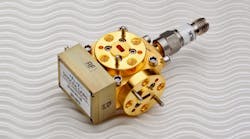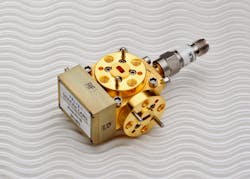This file type includes high resolution graphics and schematics when applicable.
Frequency conversion is part of a large number of RF/microwave systems, for many different applications. Signals are shifted higher or lower in frequency for different reasons, often to accommodate the signal-processing requirements of transmitters or receivers. Frequency translation can be accomplished in a number of different ways, with no clear winner for the best approach. Often a solution is chosen because of frequency range, required size, or cost. Knowing what is available in terms of frequency-conversion options can certainly help when it is time to decide which is the optimum frequency-translation technique for a particular application.
Frequency mixers are probably the most commonly used RF/microwave component for frequency conversion, whether as discrete components or as part of an integrated circuit (IC). Mixers are so named because they mix two input signals to produce an output signal. They rely on a nonlinear device, such as a Schottky diode or a GaAs field-effect transistor, to achieve the frequency translation. A mixer’s three ports (see figure) are commonly referred to as the radio frequency (RF), local oscillator (LO), and intermediate-frequency (IF) ports. The LO port is always for an input signal, typically provided by a stable, low-noise signal source that is mixed with a signal at one of the other two ports.
In a typical mixer configuration, the RF port handles a higher range of frequencies than the IF port, so that when the LO is mixed with a signal at the IF port, the two signals essentially add in frequency and a higher-frequency signal is produced at the RF port. The process is called “frequency upconversion.” When the LO is mixed with signals at the RF port, the frequencies of the two signals subtract and a lower-frequency difference signal is produced at the IF port, in a process called frequency downconversion.
Both forms of frequency conversion are widely used in high-frequency communications systems, often to upconvert signals into a frequency band reserved for modulation and transmission and then to downconvert them at a receiver for demodulation and signal processing to recover voice, video, or data carried by those signals. Mixers are available in several formats, including for single-sideband (SSB) and double-sideband (DSB) frequency conversion. In a DSB mixer, two sidebands are produced from the combining of the two input signals and available at the mixer’s output port. In an SSB mixer, one of the sidebands is filtered within the mixer, so that only one of the translated-frequency sidebands is available at the mixer’s output port.
Mixers have been fabricated with single nonlinear devices, in circuits known as single-balanced mixers, as well as with multiple diodes and transistors, known as double-balanced or triple-balanced mixers. Mixer configurations have also been optimized for specific performance characteristics, such as image-reject mixers and in-phase/quadrature (I/Q) mixers for phase-modulated signals. Frequency mixers have long proven their reliability and consistency over a wide range of operating conditions and are the most popular RF/microwave component solution for frequency conversion applications.
Frequency mixers have long been one of the most popular methods for performing frequency upconversion and/or frequency downconversion in high-frequency electronic systems.
Frequency mixers can be characterized by a number of performance parameters, including the frequency ranges of the three ports, the conversion loss of the frequency translation through the mixer, the isolation between ports, the component’s 1-dB compression point or output power, the voltage standing wave ratio (VSWR) at the ports for impedance-matching purposes, the noise figure, and the intermodulation distortion (IMD). For those seeking an introduction to frequency-mixer performance parameters, Marki Microwave offers its “Mixer Basics Primer” for free download from its website. In addition, a recent article in Microwaves & RF, “Understanding Mixers and Their Parameters,” provides a full review of key mixer-performance parameters and different mixer types.
Dividing and Multiplying
Of course, a frequency mixer is only one of a number of different approaches to RF/microwave frequency conversion, with frequency dividers and frequency multipliers also commonly used for frequency downconversion and frequency upconversion, respectively. As their names suggest, frequency dividers and frequency multipliers provide division or multiplication of an input signal typically by means of a nonlinear active device, such as a diode or a transistor, and also by means of passive circuits, such as filters that are used to select specific harmonic or subharmonic frequencies as an output from a fundamental-frequency input signal.
Frequency dividers and multipliers typically operate at integer division and multiplication ratios, according to the harmonic relationships of a signal of interest. For example, frequency dividers are commonly available in divide-by-2, divide-by-4, and divide-by-8 formats to effectively perform downconversion on an input signal. Similarly, a frequency multiplier can be specified for multiplication at integer multiplication ratios, such as multiply-by-2, multiply-by-4, and multiply-by-8 formats. Frequency dividers are often realized as integrated-circuit (IC) prescalers. These ICs can be furnished in compact surface-mount-technology (SMT) packages, with high division ratios and additional circuit functions such as amplification and filtering to minimize the number of additional components needed for frequency downconversion.
In frequency downconversion applications where extreme frequency translation may be needed, such as in a receiver to shift input RF signals to a much lower intermediate-frequency (IF) range, or for frequency synthesis in a phase-locked loop (PLL), where the phase of a higher-frequency source is being compared to a lower-frequency reference source to stabilize the higher-frequency source, prescalers with high division ratios are often used.
By combining a pair of frequency dividers in one component, it is possible to create a dual-modulus prescaler or prescaler with two selectable division ratios, such as divide-by-N and divide-by-N +1 division ratios where N is an integer. In fact, dual-modulus prescaler ICs are not uncommon, with division ratios of 32/33 and 64/65. The division ratio of such miniature frequency dividers, often supplied in SMT and multipin device packages, is typically selected by standard logic control, such as CMOS or transistor-transistor-logic (TTL) control signals.
Integrating Higher
As with frequency dividers, frequency multipliers can be designed as active or passive circuits. Passive frequency multipliers, which are most often doublers, are available for some extremely high-frequency applications, such as the model HMC1105 passive frequency multiplier from Analog Devices. It operates with input signals from 20 to 40 GHz and produces output signals from 40 to 80 GHz. (The company, which also supplies prescalers at similarly high frequencies, added a large number of frequency multiplier products with its acquisition of IC developer Hittite Microwave Corp.) Active frequency multipliers typically include frequency conversion circuitry as well as additional supporting circuit functions. Miniature frequency upconverters from MACOM, for example, provide output signals to 40 GHz in surface-mount and QFN packages. Based on balanced, image-reject mixer technology, these packaged upconverters feature a single IC that incorporates the mixer, an LO buffer amplifier, LO frequency doubler or variable attenuator, and an RF buffer amplifier.
Facing Tradeoffs
One of the tradeoffs in using these IC-based frequency-conversion devices is limited input-power range because of the small sizes of the devices. Input power for frequency translation is usually limited to 1 W (+30 dBm) or less, which results in limited-power upconverted or downconverted output signals, especially in passive devices with conversion loss. For applications such as battery-powered radios and other portable communications devices, the low signal levels are usable for many systems. But in systems that rely on higher-level signals, such as EW and radar systems, frequency-conversion solutions capable of handling larger input-signal ranges are required. This type of frequency-translation solution is usually realized in the form of a subsystem module assembled with discrete components capable of operating at higher-signal power levels
Due to size and space constraints in modern electronic systems, frequency upconversion and downconversion functions are increasingly provided as part of integrated assemblies which may include a frequency mixer, LO and IF amplification, and even a PLL-stabilized LO source. Such integrated frequency-conversion assemblies are typically tailored to a specific application and set of environmental conditions to provide optimized performance.
For generating the high-frequency signals needed for satcom systems, for example, a number of manufacturers have developed frequency upconverters known as block upconverter (BUC) or block downconverter (BDC) assemblies. Although they are physically much larger than the IC-based prescalers and multipliers used in portable applications, these frequency-conversion assemblies can be equipped with many additional useful functions, including built-in test equipment (BITE) and integrated frequency-synthesized LO sources. A BUC or BDC typically includes all necessary components, including filters and amplifiers, for full frequency translation over a required frequency range without need of additional components.
As an example, a BUC/BDC assembly developed by Mercury Systems for satcom applications at Ku-band and L-band frequencies. For satellite uplink applications, the assembly enables frequency upconversion from L-band to Ku-band frequencies. For satellite downlinks, the assembly can also perform frequency downconversion from Ku-band to L-band frequencies. The upconverter portion of the assembly includes input and output power level detection, multiple amplification stages, multiple filter stages, and programmable temperature compensation. The downconverer section features output power level detection, multiple amplification stages, multiple filter stages, and a high-performance oscillator. The assembly, which works with an external 10-MHz reference oscillator, includes PLL-stabilized synthesized
In addition to these frequency conversion methods, different filter-based approaches and techniques with nonlinear amplifiers are sometimes employed to generate and isolate desired harmonic multiples of an input signal or to create short pulses as needed for radar systems. Step-recovery diodes, for example, are often used as the basis for harmonic comb or impulse generators, to create a pulse or a higher-frequency harmonically related output signal from a supplied input signal. A line of step-recovery-diode based comb generators from Herotek works with input signals from 10 MHz to 10 GHz (and power levels to 1 W) and provides output signals to 26 GHz. These comb frequency multipliers can fit within hermetic drop-in houses for tight packaging requirements.
This is a sampling of the different frequency conversion techniques available to RF/microwave engineers, with clear differences in such attributes as frequency range, size, and power-handling capabilities. If any trend is apparent, it is the growing integration of functions found in smaller IC-based prescalers as well as in larger BUCs and BDCs. The increased integration ultimately translates into simpler design at the design level with reliable performance as a result of single-function components that have been well matched in impedance and performance levels.
This file type includes high resolution graphics and schematics when applicable.


